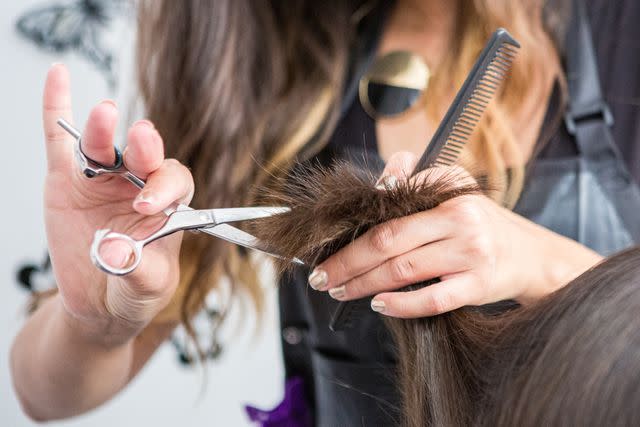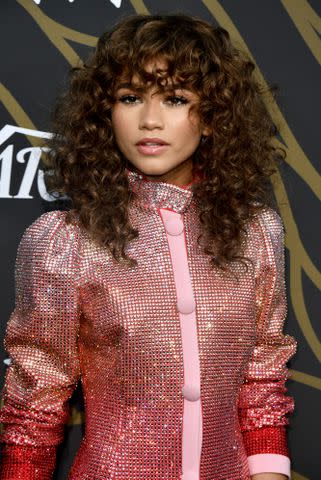Why You Should Always Ask for a Dry Haircut

Getty Images
Whether it's deciding what salon to go to or if you want a bob or a new set of bangs, there's a lot to consider when getting a haircut. One logistic you may not realize is worth ironing out? If you're going to get a dry haircut or not.
Related: 20 Medium Shag Haircut Ideas to Copy
Dry haircuts are nothing new. In fact, this type of cutting has been the go-to method for stylists for years, especially for clients with textured hair. But if it's new to you and you're looking for a way to ensure the most precise cut of your life, then a dry cut is something you'll want to look into.
Here, we tapped in-demand pros to break down everything you need to know about getting a dry haircut.
Meet Our Expert
Yetty Bames is a hairstylist at Sharon Dorram Color at the Sally Hershberger Salon.
Roz Murray is a hairstylist at Bumble and bumble in New York City.
Andrew Fitzsimons is a celebrity hairstylist and founder of haircare line Andrew Fitzsimons.
Dry Haircut Benefits

Getty Images
A dry haircut is a method of cutting hair while — you guessed it — dry. According to hairstylist Yetty Bames, this is mostly used to give pros the best visibility and avoid giving you harsh lines. Fellow hairstylist Roz Murray agrees and says that dry cutting allows them to tailor a haircut specifically to your texture and hair needs.
Celebrity hairstylist Andrew Fitzsimons says that dry cutting can help stylists see more clearly when trying to shape and style hair. “Wet hair can appear longer and is naturally weighed down, so when you are cutting hair dry, you get a very even cut and true length as you are working with your natural hair texture,” Fitzsimons explains. “When the hair is dry, you can see the length and feel the weight a lot more clearly than you can if the hair is washed first.”
Related: 20 Choppy Bob Haircut Ideas to Inspire Your Fall Refresh
“Dry cutting lets the stylist see the hair for what it really is, which results in perfecting the clients desired length, haircut, and style,” adds Bames. “Dry cutting is also beneficial to those with weak and damaged hair...as a wet cut requires tons of combing and cutting, which can further weaken the hair. A dry haircut is done, styled, and perfected, so there is less time spent doing the service while inflicting less damage.”
Murray agrees and adds that dry cuts help determine where the dead ends that need chopping are, which is especially helpful when you’re trying to maintain as much length as possible.

Getty Images
The Downsides of Dry Cuts
The downsides of a dry haircut are minimal. According to Fitzsimons, the only real drawback of a dry cut is that any mistakes made are a lot more visible and harder to fix. “This is due to the fact that you can see the way the hair will lay naturally with the length. So if a wrong move happens, it will be more noticeable,” he says. Bames agrees and adds that because a dry cut is so precise, it’s easier to mistakenly cut the hair unevenly or add a hole when giving you layers. But if you go to a trusted and well-trained stylist, you can avoid experiencing these mistakes.
Why Dry Cuts Are Popular
Simply put, dry cuts are so popular because they benefit both the stylist and the client. Murray emphasizes that dry cutting lets the stylist tailor the cut specifically to the client’s texture and needs, and the client will leave with the exact cut and style they were looking for. It's pretty much a win-win for all parties involved.
Related: 15 Wolf Cut Ideas for Curly and Wavy Hair
Hair Types Dry Cuts Work Well For

Getty Images
Dry cuts are suitable for all hair types. "We all ultimately wear our hair dry," says Bames. However, those with curly and coily hair will benefit more from a dry cut. That's because these hair types experience shrinkage when wet, which makes it "near impossible to see the hair for what it really is," she adds.
Fitzsimons agrees. "With a dry cut, it is easier to account for different textural and coil differences in curls," he says. "With certain dry methods, you can immediately see the results." So, the next time you book an appointment with your stylist, consider asking them about getting a dry haircut. With all the benefits and ease it comes with for both you and the stylist, it's inherently a no-brainer.
For more InStyle news, make sure to sign up for our newsletter!
Read the original article on InStyle.


